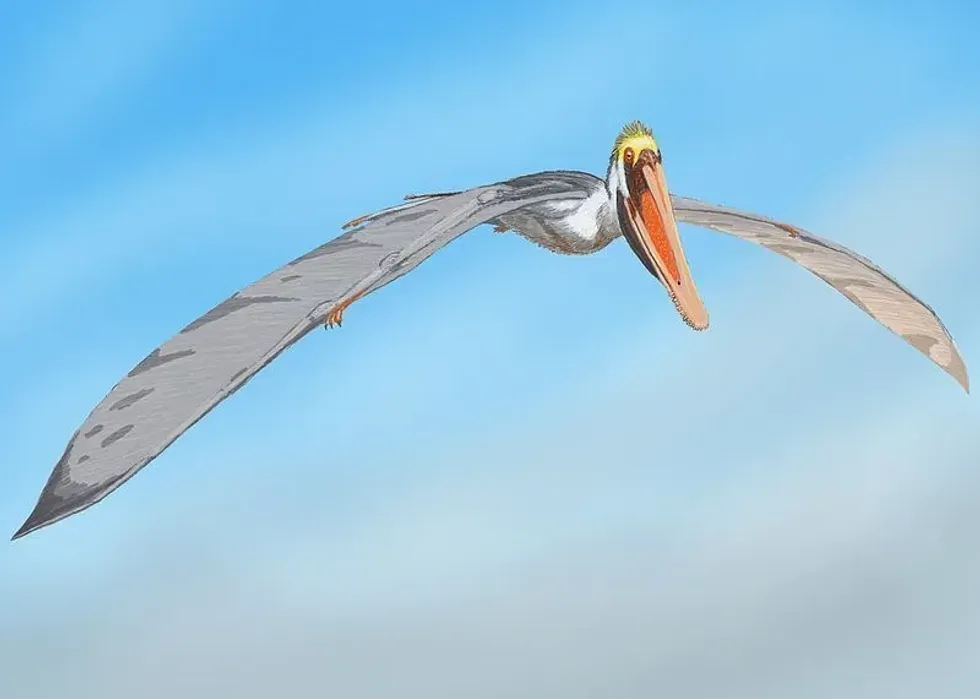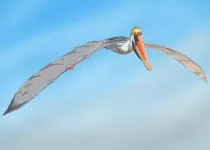Istiodactylus latidens were in the genus Ornithodesmus and were found on the continent of Europe. They were present on Earth during the early cretaceous period around 120 million years ago.
Istiodactylus latidens (meaning sail finger) belonged to the order and suborder Pterosauria, Pterodactyloidea, and are still recognized as one of the biggest flying reptiles. These species in genus Ornithodesmus had a broad skull and a long narrow jaw and inside that, had sharp teeth.
They enjoyed a carnivorous diet and ate other grazing reptiles whom they could kill. Istiodactylus were pterosaurs that had an average flight speed of around 80 mph (128.7 kph). They had huge wings around 14-16 ft (4.3-4.9 m) long.
They had long legs but were devoid of tails. In short, they were one of the amazing reptiles.
This was just the introduction. For more interesting and fun facts about this dinosaur, keep reading the article! And for more relevant content, read our Plesiosaurus facts and Titanosaurus facts for kids.
Istiodactylus Interesting Facts
How do you pronounce 'Istiodactylus'?
Istiodactylus were pterosaur species that were present on Earth during the early cretaceous period around 120 million years ago. They were flying dinosaurs who were aggressive in nature. Now pronouncing 'Istiodactylus' can be a bit tricky. Pronunciation differs from accent to accent but the most common way of pronouncing it is 'is tio dac tilis'.
What type of dinosaur was an Istiodactylus?
Istiodactylus were pterosaur species that roamed the early cretaceous sky around 120 million years ago. Their remains have been studied carefully and some classification has been done.
According to the Istiodactylus specimen, they were in the genus Ornithodesmus. They belonged to the order Pterosauria and suborder Pterodactyloidea, family Istiodactylidae and subfamily Istiodactylinae. Their genus name is Istiodactylus and their scientific name is Istiodactylus latidens and Istiodactylus sinensis.
In which geological period did the Istiodactylus roam the earth?
According to the studies that have been done on their remains to unfold their history, it was clear that they were present on Earth during the Early Cretaceous period to the Lower Cretaceous period around 120 million years ago.
When did the Istiodactylus become extinct?
Pterosaurs species Istiodactylus were present on Earth during the Early Cretaceous period to the Lower Cretaceous period. The fossils that were found narrated that these reptile birds lived on Earth around 120 million years ago. It is believed that they went extinct a little before the beginning of the Late Cretaceous period.
Where did an Istiodactylus live?
Istiodactylus were aerial creatures who roamed the sky. It is believed that they were carnivorous birds who were present in the continent of Europe.
What was an Istiodactylus' habitat?
Istiodactylus sinensis were in the family Istiodactylidae and inhabited the continent of Europe. They roamed the Earth during the early cretaceous period around 120 million years ago. Their fossil remains were found from the Wessex Formation of the Isle of Wight. It is assumed that they once lived there.
Who did an Istiodactylus live with?
There is no data available that proves that Istiodactylus were solitary or social in nature. But it is assumed that Istiodactylus latidens were social feeders. They used to hunt bigger herbivores, though that's not possible if they were not attacking in packs.
How long did an Istiodactylus live?
Istiodactylus from order and suborder Pterosauria, Pterodactyloidea were flying dinosaurs who lived in the Wessex Formation of the Isle of Wight near England and are believed to have been present on Earth for more than 4 million years. There is no exact information available on how long an Istiodactylus lived.
How did they reproduce?
They were reptiles and because of that, they laid eggs in order to give birth. They were bird-like animal species so would have reproduced like birds too.
Istiodactylus Fun Facts
What did an Istiodactylus look like?

According to the Istiodactylus specimen remains, they were in the genus of pterosaurs who roamed around Europe. Their fossil was excavated from the Wessex Formation of the Isle of Wight near England.
They had a magnificent physical description. Istiodactylus being pterosaurs had a broad skull and a low snout part.
The classification of the broad skull and low snout was common in all pterosaur species. These flying animals had strong jaws (beaks) with sharp and strong teeth.
These reptiles from the genus Ornithodesmus had broad wings. According to their fossil studies, they had huge wings, the wingspan length is assumed to be around 14-16 ft (4.3-4.9 m).
There are no exact details available on their body length and weight but it can be said that Istiodactylus dinosaurs were the largest of all dinosaurs in the family Istiodactylidae.
Their tail was somewhat very small to nonexistent. Being carnivorous, each tooth in their jaw or beak was built in such a way that it was difficult for their prey to detach themselves from their bite.
They had long and thin legs and also had claws (hand with finger) at the top corners of their wings. As per the description, Istiodactylus latidens were one of the biggest pterosaur species.
How many bones did an Istiodactylus have?
Pterosaur species in the genus Ornithodesmus, Istiodactylus were flying reptiles from the Early Cretaceous period. There is no record of exactly how many bones they had because the fossil remains that were found were partial.
How did they communicate?
This is still a big mystery. Istiodactylus in the genus Ornithodesmus were flying reptiles. They would have communicated through their signature calls or might have had a screeching voice. We can assume only!
How big was an Istiodactylus?
Istiodactylus latidens in the genus Ornithodesmus were big flying reptiles. Istiodactylus' skull was broad in size and had a long jaw that seemed like a beak.
Inside that, there were sharp teeth for hunting purposes. Their physical description was awesome. There is no exact information on their length and weight but the range of their wingspan is estimated around 14-16 ft (4.3-4.9 m).
How fast could an Istiodactylus move?
Pterosaurs could fly at a speed of 80 mph (128.7 kph).
How much did an Istiodactylus weigh?
There is no exact information available on their weight.
What were the male and female names of the species?
There are no sex-specific names for male or female Istiodactylus.
What would you call a baby Istiodactylus?
Like all dino babies, a baby Istiodactylus is also known as a hatchling.
What did they eat?
Their diet was mainly carnivorous. According to their classification, it is believed that they were meat-eating dinosaurs in the genus Ornithodesmus who were group feeders. They used to hunt herbivorous animals.
How aggressive were they?
Istiodactylus were big flying reptiles. They had a carnivorous diet and because they were meat-eaters it can be easily assumed that they were aggressive.
Did you know...
The fossil of Istiodactylus was found in the year 1887 on the Isle of Wight near England.
Could the Istiodactylus fly?
Yes, Istiodactylus could fly. From the holotype skeleton studies, it has been cleared that they were one of the biggest reptiles who could fly.
What does pterodactyl mean?
Pterodactyl in greek means 'winged finger'. Like pterodactyl, Istiodactylus in greek means 'sail finger'. It has a Latin meaning that also means 'wide tooth'.
Here at Kidadl, we have carefully created lots of interesting family-friendly dinosaur facts for everyone to discover! Learn more about some other creatures from our Ziapelta fun facts, or Kryptodrakon facts for kids.
You can even occupy yourself at home by coloring in one of our free printable pterodactyl coloring pages.
Main image by Dmitry Bogdanov
Second image by Mark P. Witton









